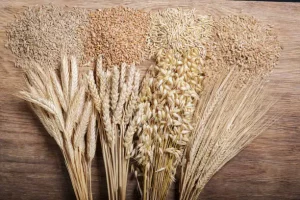What Does Gluten-friendly Mean? Gluten-Friendly Vs Gluten-Free
When it comes to following a gluten-free lifestyle, gluten plays a vital role. So naturally, you have some questions in your mind. What Does Gluten-friendly Mean? and the comparision between Gluten-friendly Vs Gluten-Free?
The term “gluten friendly” is usually used at restaurants which means that a food/product/diet includes foods that contain small amounts of gluten as long as they don’t have an adverse effect on health. This means that you can still eat some products that contain wheat, barley, and rye but in smaller quantities than recommended by a strict gluten-free diet.
I believe, for people with celiac disease or gluten sensitivity, being able to read product labels containing gluten is very important to maintain gluten friendly lifestyle. My guide will help you enjoy the benefits and flavors of certain grains without experiencing any negative consequences from consuming them in large amounts.
Want to know Is Gluten Halal? (Islamic references for Gluten)
What Is Meant By Gluten Free?
While gluten-friendly diets allow for small amounts of gluten to be consumed, a strictly gluten-free diet does not allow any food containing wheat, barley, or rye to be eaten. This is usually recommended for those who have been diagnosed with Celiac Disease, an autoimmune disorder caused by gluten sensitivity.
What Is Gluten-friendly Diet?
It is important to understand the difference between a gluten-friendly diet and a strictly gluten-free one. A gluten-friendly diet allows for foods that contain small amounts of gluten as long as they don’t have an adverse effect on health. This means that you can still eat some products that contain wheat, barley, and rye but in smaller quantities than recommended by a strict gluten-free diet.
On the other hand, a strictly gluten-free diet does not allow any food containing wheat, barley, or rye to be eaten. It is usually recommended for those who have been diagnosed with Celiac Disease, an autoimmune disorder caused by gluten sensitivity. Additionally, foods labeled with “certified gluten-free” must contain less than 20 parts per million of gluten and must not be contaminated with wheat, barley, or rye during production.
How to make sure your Gluten-free products are in line with the FDA’s standards
In order to ensure that your gluten-free products meet the FDA’s standards (guide), it is important to look for labels that state “gluten-free” or “made without wheat, barley, and rye.”
Additionally, the FDA requires companies to use a certified gluten-free guarantee on their packaging if they are claiming that their product is truly gluten-free. This provides further assurance that any trace amounts of these grains have been kept at an acceptable level according to the FDA’s requirements.
Furthermore, some companies offer third-party testing in order to confirm that their ingredients and production processes do not contain any traces of these grains. By following these steps, you can rest assured that your gluten-free products are safe and in line with the FDA’s standards.
Click Here to Get Info About:
Does Gluten-Friendly Mean Gluten-Free?
No, gluten-friendly does not necessarily mean gluten-free. While a gluten-friendly diet seeks to minimize the consumption of grains containing gluten, such as wheat, barley, and rye, it does not completely eliminate them from the diet.
Therefore, products labeled “gluten friendly” may still contain trace amounts of these grains. It is important to note that for individuals with celiac disease or other severe allergies to gluten, a strict gluten-free diet must be followed in order to avoid any reaction or health issues.
What Is Gluten?
Gluten is a protein found primarily in wheat, barley, and rye. It is also commonly used as an additive in many processed foods such as sauces, soups, and baked goods. Gluten is responsible for the elastic texture of doughs and helps them rise. It is also found in some medications and dietary supplements.
What’s Wrong With Gluten?
For some people, eating foods that contain gluten can cause a range of unpleasant and even dangerous symptoms such as abdominal pain, bloating, diarrhea, and fatigue. In some cases, it can also lead to serious long-term health complications such as osteoporosis, infertility, and certain types of cancer.
Comparison Between Gluten-friendly Vs Gluten-Free?
Gluten-friendly and gluten-free are two different dietary approaches when it comes to eating grains that contain gluten. Gluten-friendly diets seek to minimize the consumption of grains containing gluten, such as wheat, barley, and rye, while gluten-free diets eliminate these grains from the diet entirely. Individuals with celiac disease or other severe allergies to gluten often need to adhere to a strict gluten-free diet in order to avoid any reaction or health issues.
In addition, food products labeled “gluten friendly” may still contain trace amounts of these grains whereas those labeled “gluten-free” must be made without wheat, barley, and rye according to FDA regulations.
What Does Certified Gluten Free Mean?
Foods that are labeled “certified gluten-free” must contain less than 20 parts per million of gluten. This is the legal standard set by the Food and Drug Administration (FDA). Additionally, foods labeled with this certification must not be contaminated with wheat, barley, or rye during their production process.
What Does Wheat Free Mean?
A wheat-free diet excludes all products containing wheat but still allows for other grains like barley and rye. It is usually recommended for those who have been diagnosed with a wheat allergy or intolerance but not Celiac Disease.
What Does Made Without Gluten Mean?
Food items that are labeled as “made without gluten” can still contain trace amounts of wheat, barley, or rye but these must be below 20 parts per million and certified by the FDA. This labeling is usually used to indicate that a product was made without the intention of adding gluten-containing ingredients.
Identifying Gluten-Free Foods And Products
Identifying gluten-free foods is one of the most important steps in maintaining a gluten-friendly diet. When shopping for groceries, look for labels that list “gluten-free” or “made without wheat, barley, and rye” to ensure that the products you are buying do not contain any traces of these grains. Additionally, some companies may provide a certified gluten-free guarantee on their packaging as an added assurance. Fortunately, more and more products are labeled as such every day which makes it easier to find wheat-, barley-, and rye-free food items.
It can also be beneficial to familiarize yourself with other names of gluten-containing grains such as spelled, kamut, farro, durum, and semolina. These grains can be found in various types of processed foods such as bread, pastas, and even canned soups that are not labeled as gluten-free. To stay safe, always read the nutrition label before you purchase packaged food or inquire about ingredients if eating out at a restaurant. With these tools in hand, you can make sure to enjoy delicious meals while still keeping up with your gluten-free lifestyle!
Conclusion:
By taking the time to understand exactly What does Gluten-friendly Mean? and how you can make more informed decisions when it comes to your nutrition and health. Whether you’re looking for delicious recipes that fit into a gluten-free lifestyle(read my guide) or just want to be aware of which foods contain wheat, barley, and rye, understanding what “gluten friendly” really means will help you make better choices for a healthier life.
I will love to listen to what you think of gluten-free lifestyle and how do you maintain yoruself. Let me know in the comment section what you think.












![Gluten-Free Christmas Tree Cakes [delightful holiday treat]](https://glutenfreedream.com/wp-content/uploads/2023/05/Gluten-Free-Christmas-Tree-Cakes-1-768x513.webp)
